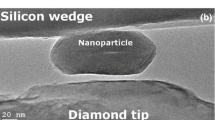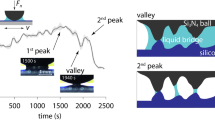Abstract
From the classic Amonton’s law, there was a positive correlation between the frictional force and the normal load when a solid surface slid. However, the negative coefficient of friction behavior found in the experiment was completely different from our perception, that is, the negative correlation between friction and normal load. Since the current experimental observations and theoretical calculation predictions of the negative friction coefficient are mostly based on the deformation of the sample layer during the friction process or the participation of lubricants such as water film, it is necessary to study the behavior of the negative friction coefficient in a purely rigid system. Through first-principles calculations, we simulated the probe in the non-jump-to-contact area and observed the behavior of the negative friction coefficient in the non-deformed borophene rigid interface, and it can be combined with traditional atomic force microscope experiments to provide experimental results. The observation of the negative friction coefficient behavior of the rigid interface provides feasibility and guidance.







Similar content being viewed by others
References
Berman, A., Drummond, C., Israelachvili, J.: Amontons’ law at the molecular level. Tribol. Lett. 4, 95–101 (1998). https://doi.org/10.1023/A:1019103205079
Gao, J.P., Luedtke, W.D., Gourdon, D., Ruths, M., Israelachvili, J.N., Landman, U.: Frictional forces and Amontons’ law: From the molecular to the macroscopic scale. J Phys Chem B 108, 3410–3425 (2004). https://doi.org/10.1021/jp036362l
An, R., Zhou, G., Zhu, Y., Zhu, W., Huang, L., Shah, F.U.: Friction of Ionic Liquid-Glycol ether mixtures at titanium interfaces: negative load dependence. Adv Mater Inter (2018). https://doi.org/10.1002/admi.201800263
Chen, J., Gao, W.: Unconventional Behavior of Friction at the Nanoscale beyond Amontons’ Law. Chem Phys Chem 18, 2033–2039 (2017). https://doi.org/10.1002/cphc.201700378
Deng, Z., Smolyanitsky, A., Li, Q., Feng, X.Q., Cannara, R.J.: Adhesion-dependent negative friction coefficient on chemically modified graphite at the nanoscale. Nat Mater 11, 1032–1037 (2012). https://doi.org/10.1038/nmat3452
Li, H., Shi, W.H., Guo, Y.F., Guo, W.L.: Nonmonotonic interfacial friction with normal force in two-dimensional crystals. Physical Rev B (2020). https://doi.org/10.1103/PhysRevB.102.085427
Liu, B., Wang, J., Zhao, S., Qu, C., Liu, Y., Ma, L., et al.: Negative friction coefficient in microscale graphite/mica layered heterojunctions. Sci Adv 6, 6787 (2020). https://doi.org/10.1126/sciadv.aaz6787
Liu, Z.: The diversity of friction behavior between bi-layer graphenes. Nanotechnology 25, 075703 (2014). https://doi.org/10.1088/0957-4484/25/7/075703
Mandelli, D., Ouyang, W., Hod, O., Urbakh, M.: Negative friction coefficients in superlubric graphite-hexagonal boron nitride heterojunctions. Phys Rev Lett 122, 076102 (2019). https://doi.org/10.1103/PhysRevLett.122.076102
Smolyanitsky, A., Killgore, J.P.: Anomalous friction in suspended graphene. Phys. Rev. B (2012). https://doi.org/10.1103/PhysRevB.86.125432
Sun, J., Lu, Y., Feng, Y., Lu, Z., Zhang, G.A., Yuan, Y., et al.: Friction-Load Relationship in the Adhesive Regime Revealing Potential Incapability of AFM Investigations. Tribol. Lett. (2020). https://doi.org/10.1007/s11249-019-1263-7
Sun, J., Zhang, Y., Lu, Z., Li, Q., Xue, Q., Du, S., et al.: Superlubricity enabled by pressure-induced friction collapse. J Phys Chem Lett 9, 2554–2559 (2018). https://doi.org/10.1021/acs.jpclett.8b00877
Sun, J., Zhang, Y., Lu, Z., Xue, Q., Wang, L.: Attraction induced frictionless sliding of rare gas monolayer on metallic surfaces: an efficient strategy for superlubricity. Phys Chem Chem Phys 19, 11026–11031 (2017). https://doi.org/10.1039/c6cp08857k
Thormann, E.: Negative friction coefficients. Nat Mater 12, 468 (2013). https://doi.org/10.1038/nmat3656
Urbakh, M., Klafter, J., Gourdon, D., Israelachvili, J.: The nonlinear nature of friction. Nature 430, 525–528 (2004). https://doi.org/10.1038/nature02750
Ye, Z., Martini, A.: Atomistic simulation of the load dependence of nanoscale friction on suspended and supported graphene. Langmuir 30, 14707–14711 (2014). https://doi.org/10.1021/la503329u
Deng, Z., Klimov, N.N., Solares, S.D., Li, T., Xu, H., Cannara, R.J.: Nanoscale interfacial friction and adhesion on supported versus suspended monolayer and multilayer graphene. Langmuir 29, 235–243 (2013). https://doi.org/10.1021/la304079a
Righi, M.C., Ferrario, M.: Pressure induced friction collapse of rare gas boundary layers sliding over metal surfaces. Phys Rev Lett 99, 176101 (2007). https://doi.org/10.1103/PhysRevLett.99.176101
Sun, J., Chang, K., Mei, D., Lu, Z., Pu, J., Xue, Q., et al.: Mutual identification between the pressure-induced superlubricity and the image contrast inversion of carbon nanostructures from afm technology. J Phys Chem Lett 10, 1498–1504 (2019). https://doi.org/10.1021/acs.jpclett.9b00155
Sun, J., Zhang, Y., Feng, Y., Lu, Z., Xue, Q., Du, S., et al.: How vertical compression triggers lateral interlayer slide for metallic molybdenum disulfide? Tribol. Lett. (2017). https://doi.org/10.1007/s11249-017-0971-0
Erts, D., Lohmus, A., Lohmus, R., Olin, H., Pokropivny, A.V., Ryen, L., et al.: Force interactions and adhesion of gold contacts using a combined atomic force microscope and transmission electron microscope. Appl. Surf. Sci. 188, 460–466 (2002). https://doi.org/10.1016/S0169-4332(01)00933-3
Landman, U., Luedtke, W.D., Burnham, N.A., Colton, R.J.: Atomistic mechanisms and dynamics of adhesion, nanoindentation, and fracture. Science 248, 454–461 (1990). https://doi.org/10.1126/science.248.4954.454
Jiang, X., Lu, Z., Zhang, R.: The unusual tribological properties of graphene/antimonene heterojunctions: a first-principles investigation. Materials (Basel) (2021). https://doi.org/10.3390/ma14051201
Li, X., Zhang, D.K., Lee, K.R.: Exploring the different roles of graphene and its derivatives as nano-additives at amorphous carbon surface through reactive molecular dynamics approach. Comp Mater Sci (2021). https://doi.org/10.1016/j.commatsci.2021.110499
Zhang, R., Chen, Q., Fan, X., He, Z., Xiong, L., Shen, M.: In Situ Friction-Induced Graphene Originating from Methanol at the Sliding Interface between the WC Self-Mated Tribo-Pair and Its Tribological Performance. Langmuir 36, 3887–3893 (2020). https://doi.org/10.1021/acs.langmuir.9b03963
Zhang, R., Yang, X., Pu, J., He, Z., Xiong, L.: Extraordinary macroscale lubricity of sonication-assisted fabrication of MoS2 nano-ball and investigation of in situ formation mechanism of graphene induced by tribochemical reactions. Appl. Surf. Sci. (2020). https://doi.org/10.1016/j.apsusc.2020.145456
Leng, S., Sun, X., Yang, Y., Zhang, R.: Borophene as an anode material for Zn-ion batteries: a first-principles investigation. Mater. Res. Express (2019). https://doi.org/10.1088/2053-1591/ab1a88
Kiraly, B., Liu, X., Wang, L., Zhang, Z., Mannix, A.J., Fisher, B.L., et al.: Borophene Synthesis on Au(111). ACS Nano 13, 3816–3822 (2019). https://doi.org/10.1021/acsnano.8b09339
Feng, B., Sugino, O., Liu, R.Y., Zhang, J., Yukawa, R., Kawamura, M., et al.: Dirac Fermions in Borophene. Phys Rev Lett 118, 096401 (2017). https://doi.org/10.1103/PhysRevLett.118.096401
Gao, M., Yan, X.W., Wang, J., Lu, Z.Y., Xiang, T.: Electron-phonon coupling in a honeycomb borophene grown on Al(111) surface. Phys Rev B (2019). https://doi.org/10.1103/PhysRevB.100.024503
Li, W.B., Kong, L.J., Chen, C.Y., Gou, J., Sheng, S.X., Zhang, W.F., et al.: Experimental realization of honeycomb borophene. Science Bulletin 63, 282–286 (2018). https://doi.org/10.1016/j.scib.2018.02.006
Ren, M., Zhang, L., Zhu, Y., Shi, J., Zhao, X., Ren, X., et al.: Highly efficient catalytic properties of Sc and Fe single atoms stabilized on a honeycomb borophene/Al(111) heterostructure via a dual charge transfer effect. Nanoscale 13, 5875–5882 (2021). https://doi.org/10.1039/d0nr08065a
Li, J.Z., Tritsaris, G.A., Zhang, X.Y., Shi, B.W., Yang, C., Liu, S.Q., et al.: Monolayer honeycomb borophene: A promising anode material with a record capacity for lithium-ion and sodium-ion batteries. J Electrochem Soc (2020). https://doi.org/10.1149/1945-7111/ab8a9b
Lin, T., Chen, I.W., Liu, F., Yang, C., Bi, H., Xu, F., et al.: Nitrogen-doped mesoporous carbon of extraordinary capacitance for electrochemical energy storage. Science 350, 1508–1513 (2015). https://doi.org/10.1126/science.aab3798
Lee, C.C., Feng, B.J., D’angelo, M., Yukawa, R., Liu, R.Y., Kondo, T., et al.: Peculiar bonding associated with atomic doping and hidden honeycombs in borophene. Phys Rev B (2018). https://doi.org/10.1103/PhysRevB.97.075430
Yin, Y., Li, D., Hu, Y., Ding, G., Zhou, H., Zhang, G.: Phonon stability and phonon transport of graphene-like borophene. Nanotechnology 31, 315709 (2020). https://doi.org/10.1088/1361-6528/ab824c
Wang, Z.-Q., Lü, T.-Y., Wang, H.-Q., Feng, Y.P., Zheng, J.-C.: Review of borophene and its potential applications. Front Phys (2019). https://doi.org/10.1007/s11467-019-0884-5
Yan, L., Liu, P.F., Li, H.T., Tang, Y., He, J.J., Huang, X.Y., et al.: Theoretical dissection of superconductivity in two-dimensional honeycomb borophene oxide B2O crystal with a high stability. NPJ Comput. Mater. (2020). https://doi.org/10.1038/s41524-020-00365-9
Lee, A.J., Sakai, Y., Chelikowsky, J.R.: Simulating contrast inversion in atomic force microscopy imaging with real-space pseudopotentials. Phys Rev B (2017). https://doi.org/10.1103/PhysRevB.95.081401
Gross, L., Mohn, F., Moll, N., Liljeroth, P., Meyer, G.: The chemical structure of a molecule resolved by atomic force microscopy. Science 325, 1110–1114 (2009). https://doi.org/10.1126/science.1176210
Sakai, Y., Lee, A.J., Chelikowsky, J.R.: First-Principles Atomic force microscopy image simulations with density embedding theory. Nano Lett 16, 3242–3246 (2016). https://doi.org/10.1021/acs.nanolett.6b00741
Xu, Y.P., Cheng, Z.W., Zhu, X.H., Lu, Z.B., Zhang, G.A.: Ultra-Low Friction of Graphene/Honeycomb Borophene Heterojunction. Tribol. Lett. (2021). https://doi.org/10.1007/s11249-021-01418-w
Hohenberg, P., Kohn, W.: Inhomogeneous Electron Gas. Phys Rev 136, B864–B871 (1964). https://doi.org/10.1103/PhysRev.136.B864
Ayers, P.W., Levy, M.: Perspective on Density functional approach to the frontier-electron theory of chemical reactivity. Theoretical Chemistry Accounts: Theory, Computation, and Modeling 103, 353–360 (2000). https://doi.org/10.1007/s002149900093
Guo, Y., Qiu, J., Guo, W.: Reduction of interfacial friction in commensurate graphene/h-BN heterostructures by surface functionalization. Nanoscale 8, 575–580 (2016). https://doi.org/10.1039/c5nr05806f
Liang, T., Sawyer, W.G., Perry, S.S., Sinnott, S.B., Phillpot, S.R.: First-principles determination of static potential energy surfaces for atomic friction inMoS2andMoO3. Phys Rev B (2008). https://doi.org/10.1103/PhysRevB.77.104105
Wang, L.F., Ma, T.B., Hu, Y.Z., Zheng, Q., Wang, H., Luo, J.: Superlubricity of two-dimensional fluorographene/MoS2 heterostructure: a first-principles study. Nanotechnology 25, 385701 (2014). https://doi.org/10.1088/0957-4484/25/38/385701
Wang, M.Y., Li, C.H., Abernathy, D.L., Song, Y., Carr, S.V., Lu, X.Y., et al.: Neutron scattering studies of spin excitations in superconducting Rb082Fe168Se2. Phys. Rev. B (2012). https://doi.org/10.1103/PhysRevB.86.024502
Zilibotti, G., Righi, M.C.: Ab initio calculation of the adhesion and ideal shear strength of planar diamond interfaces with different atomic structure and hydrogen coverage. Langmuir 27, 6862–6867 (2011). https://doi.org/10.1021/la200783a
Hirshfeld, F.L.: Bonded-atom fragments for describing molecular charge-densities. Theor Chim Acta 44, 129–138 (1977). https://doi.org/10.1007/Bf00549096
Acknowledgements
This work was supported by National Natural Science Foundation of China (No. 11972344).
Author information
Authors and Affiliations
Corresponding authors
Ethics declarations
Conflict of interest
There are no conflicts to declare.
Additional information
Publisher's Note
Springer Nature remains neutral with regard to jurisdictional claims in published maps and institutional affiliations.
Supplementary Information
Below is the link to the electronic supplementary material.
Rights and permissions
About this article
Cite this article
Xu, Y., Zhu, X., Cheng, Z. et al. Borophene: Provides the Possibility to Observe the Behavior of a Negative Friction Coefficient in a Rigid Interface. Tribol Lett 70, 45 (2022). https://doi.org/10.1007/s11249-022-01586-3
Received:
Accepted:
Published:
DOI: https://doi.org/10.1007/s11249-022-01586-3




